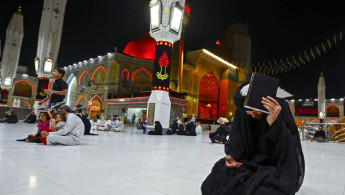Five places Pope Francis will see on his exceptional Iraq trip
Here are five key locations the pontiff is set to visit.
1. Beleaguered Baghdad
On his first day in the Iraqi capital, Francis will give a speech at the "Our Lady of Salvation" Catholic Church in the main commercial district of Karrada.
On October 31, 2010, Islamist militants stormed the church and killed 44 worshippers, two priests and seven security force personnel in one of the deadliest attacks on Iraq's dwindling Christian community.
Now, stained-glass windows at the church bear the victims' names and a defiant message above the altar reads: "Where is your victory, oh death?".
But the congregation has decreased and concrete blast walls surround the church, making access difficult.
In the days leading up to the Pope's arrival, an Iraqi artist painted his likeness across those concrete walls, alongside the Iraqi flag and doves representing peace.
2. Shrine city of Najaf
As part of his outreach to Muslims, the Pope will visit Najaf, the 1,230-year-old city that is the spiritual capital of most Shiites around the world.
Its imposing shrine - with a golden dome and intricate tiles inside - is the burial place of the Prophet Mohammed's son-in-law Ali, highly revered in Shia Islam.
Twitter Post
|
Britain took control of the city while it was under Ottoman rule during the First World War, holding on despite a revolt by local clerics.
Former Iraqi dictator Saddam Hussein banned pilgrimages to the holy city, but it witnessed a revival after he was ousted in the 2003 US-led invasion.
In Najaf, Pope Francis will meet with Grand Ayatollah Ali Sistani, the top authority for most Shiite Muslims.
The 90-year-old cleric is never seen in public and rarely grants access to visitors, making the encounter one of the most extraordinary parts of the papal trip.
The two will meet in Sistani's humble one-storey home, with most press barred from attending the sit-down.
3. Abraham's birthplace
From there, the Pope will travel to the desert location of Ur, which was founded in the fourth millennium before Christ and became a major city in the ancient Sumero-Akkadian empire.
Its most important feature is its ziggurat, a staggered, pyramid-like structure that was excavated between the two world wars.
Ur, thought to mean "town" in Sumerian, is believed to be where Abraham - the father of Judaism, Christianity and Islam - was born in the second millenium BCE.
Pope Francis will hold an interreligious service there with some of Iraq's smallest minorities, including the Yazidis and the pre-Islamic Sabeans.
4. Mosul and Qaraqosh
The northern province of Nineveh is the heartland of Iraq's Christian community and its capital, Mosul, is where the Islamic State group chose to announce the establishment of its "caliphate" in 2014.
In Mosul, the Pope will visit the Al-Tahera Church in the city's west, which was ravaged by IS and the fighting that eventually forced the jihadists out of the city.
The first written records on Al-Tahera date back to the 17th century but some historians believe it could be as much as 1,000 years older.
During fighting in 2017, its roof caved in but the colonnaded royal door and side doors survived.
UNESCO is currently working to rehabilitate it and other parts of Mosul's heritage, including both churches and mosques.
About 30 kilometres to the south lies Qaraqosh, also known as Bakhdida and Hamdaniya, which has a long pre-Christian history but whose residents today speak a modern dialect of Aramaic, a 3,000 year-old-language still used for religious practice and study.
Qaraqosh was largely destroyed by IS and the security situation remains tense, with state-sponsored armed groups deployed in large numbers in the surrounding plains.
5. Arbil, the refuge
One of the Pope's final stops will be an open-air mass in Arbil, the capital of Iraq's Kurdish region (KRI).
When IS overran Iraq's north, hundreds of thousands of Christians as well as Muslims and Yazidis sought refuge in the KRI, which was already hosting displaced minorities from previous rounds of conflict in Iraq.
There are traces of human settlement in Arbil as far back as the fifth millennium BCE. It went on to become a major urban hub and maintained that status through the Assyrian period.
Arbil's citadel, a massive hilltop complex overlooking the city's bazaar, was put on UNESCO's World Heritage Site list in 2014.
Follow us on Facebook, Twitter and Instagram to stay connected





 Follow the Middle East's top stories in English at The New Arab on Google News
Follow the Middle East's top stories in English at The New Arab on Google News
![Netanyahu furiously denounced the ICC [Getty]](/sites/default/files/styles/image_330x185/public/2024-11/GettyImages-2169352575.jpg?h=199d8c1f&itok=-vRiruf5)
![Both Hamas and the Palestinian Authority welcomed the ICC arrest warrants [Getty]](/sites/default/files/styles/image_330x185/public/2024-11/GettyImages-2178351173.jpg?h=199d8c1f&itok=TV858iVg)
